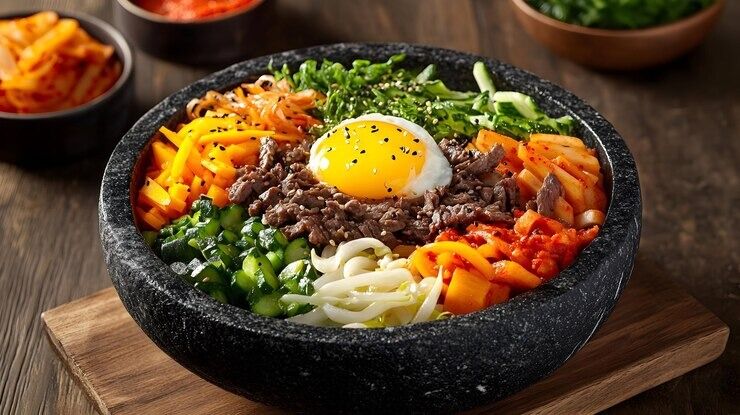Introduction

Bibimbap, the colorful and nourishing Korean rice bowl, has long been a symbol of harmony and balance. With its vibrant mix of vegetables, savory meats, and the unmistakable kick of gochujang (Korean chili paste), it has captured the attention of food lovers worldwide. Today, you can find Bibimbap not only in Seoul’s bustling streets but also in trendy food halls across New York, London, and Sydney.
But as Bibimbap travels the world, another story unfolds alongside it—the story of how traditional cuisine is adapting to the modern demand for sustainability. While people love ordering Bibimbap for dine-in, takeaway, or delivery, the packaging used often tells a very different story: single-use plastics, non-recyclable lids, and containers that pile up as waste.
This tension raises an important question: how can a dish so deeply rooted in balance and harmony align itself with eco-friendly solutions in today’s foodservice industry? The answer lies in compostable packaging—particularly molded fiber products made from bagasse (sugarcane pulp).
Bibimbap’s Global Journey
To understand why packaging matters so much, it’s worth looking at Bibimbap’s journey from a humble Korean comfort food to a global phenomenon.
In Korea, Bibimbap is more than just a meal—it is a cultural emblem. The word itself means “mixed rice,” representing unity, diversity, and balance. Traditionally served in a hot stone bowl (dolsot), the sizzling rice and toppings embody warmth and hospitality.
Over the last two decades, however, Bibimbap has leapt into the international culinary scene. Korean restaurants around the world showcase it as a signature dish, while mainstream fast-casual brands have even adopted Bibimbap-inspired bowls to meet the growing appetite for healthy, customizable meals.
This rise in popularity has also shifted how Bibimbap is consumed. It’s no longer just a sit-down dining experience; it’s increasingly delivered in takeaway containers or ordered as a quick grab-and-go lunch. That convenience comes with a price: more disposable packaging.
Korea’s Push for Sustainability in Food Packaging
Interestingly, South Korea itself is one of the strictest countries when it comes to regulating single-use plastics. Over the last few years, the Korean government has introduced sweeping restrictions:
- Plastic straws and stirrers have been banned in cafes.
- Restaurants are no longer allowed to provide free plastic utensils.
- Disposable plastic cups are restricted for dine-in services.
According to South Korea’s Ministry of Environment, as of April 1, 2022, disposable plastic cups, straws, and stirrers have been prohibited in cafes and restaurants. Starting November 24, 2022, the ban was extended to include paper cups and plastic bags in retail businesses such as convenience stores.
These policies reflect a nationwide push toward sustainability, and restaurants and food platforms are responding. Delivery apps, for instance, now allow customers to opt out of disposable cutlery. Cafes and eateries are searching for compostable alternatives.
For Bibimbap vendors, this shift creates both challenges and opportunities. The challenge is finding packaging that can handle hot, oily, and colorful ingredients without leaking or breaking down too quickly. The opportunity is winning over eco-conscious customers who actively prefer businesses that go green.
Why Bibimbap Needs Compostable Packaging
Bibimbap is not your average rice dish. It’s a layered, multi-component meal that places unique demands on its packaging:
- Diverse Ingredients: From sautéed spinach and carrots to marinated beef, fried egg, and gochujang, the variety creates flavor—but also requires containers that can resist oil and moisture.
- Multiple Components: Bibimbap often comes with separate sauces or side dishes, making portioning and compartmentalization important.
- Delivery-Friendly: Long-distance deliveries require sturdy containers that don’t collapse, leak, or compromise food presentation.
In short, Bibimbap needs packaging that’s durable, food-safe, and eco-friendly—all at the same time. That’s where compostable molded fiber packaging steps in.
Compostable Solutions for Korean Cuisine
Packaging Bibimbap sustainably isn’t just about choosing one container—it’s about matching the right solution to each part of the meal. A warm rice bowl, a neatly separated combo set, and a flavorful sauce all need different types of packaging to travel well and stay fresh.
Bagasse Bowls
When it comes to packing Bibimbap, bowls are the most practical choice. Unlike plates, which are shallow and prone to spillage, bowls can securely hold rice and toppings for delivery.
At InNature Pack, we offer a variety of bagasse bowls tailored for different needs:
- Shallow bowls for dine-in or short-distance deliveries.
- Wide-rim bowls for larger, family-style servings.
- Hexagonal bowls that add a modern aesthetic while keeping functionality intact.
For restaurants that want to highlight the colorful beauty of Bibimbap, these bowls can be paired with recyclable PET lids—allowing customers to see their food clearly while keeping it protected.
To Go Boxes (Bento Boxes)
While clamshell containers are common, they are not always the best choice for Bibimbap. Their seals can be less reliable, leading to spills or loss of freshness. A better alternative is the Bento Box–style To Go Container, which provides tighter closure and multiple compartments.
This design is especially useful for Bibimbap combos that include rice, toppings, and side dishes separately. By keeping ingredients neatly organized, the box enhances presentation and ensures the meal arrives intact.
Bagasse Sauce Cups & Lids
If Bibimbap has a soul, it’s the sauce—particularly gochujang. Offering sauce cups ensures customers can control how much spice and flavor they want. It also keeps the main dish neat during transport.
Separating the sauce from the rest of the meal not only prevents sogginess but also preserves freshness. Customers get to enjoy mixing the dish themselves, creating an interactive experience that mirrors the traditional spirit of Bibimbap.
Compostable Drinkware
No Bibimbap meal is complete without a refreshing beverage, whether it’s traditional Korean rice wine (makgeolli) or a modern iced tea. Compostable drink cups and carriers ensure that sustainability extends beyond the main dish to the entire dining experience.
Global Case Studies & Inspirations
The shift toward eco-friendly packaging isn’t just theoretical—it’s happening on the ground.
- Korean Brands Leading Change: Several restaurant chains in Seoul have adopted molded fiber bowls for rice and noodle dishes, responding to both government policies and consumer demand.
- International Expansion: In the United States and Europe, Korean restaurants are finding that eco-packaging is not just a regulatory requirement but also a marketing advantage. Customers are more likely to support restaurants that align with their values.
- Practical Success Stories: One InNature Pack client serving Asian fusion meals switched from plastic clamshells to bagasse Bento Boxes. The result? Fewer complaints about leaks, improved food presentation, and positive feedback from environmentally aware customers.
These examples highlight that sustainable packaging isn’t just good for the planet—it’s also good for business.
Benefits Beyond Sustainability
Choosing compostable packaging for Bibimbap does more than reduce plastic waste:
- Strengthens Brand Image: Restaurants that adopt eco-friendly solutions can market themselves as progressive and socially responsible.
- Builds Customer Loyalty: Diners increasingly look for businesses that reflect their values. By using compostable packaging, brands create stronger emotional connections with their audience.
- Ensures Long-Term Compliance: As global regulations around single-use plastics tighten, early adopters of compostable packaging are better prepared for the future.
For Korean cuisine businesses, the combination of delicious food and sustainable presentation is a winning formula.
Conclusion
Bibimbap represents harmony, tradition, and the coming together of many flavors into one bowl. Compostable packaging represents balance too—between customer convenience, environmental responsibility, and business sustainability.
As Korean cuisine continues to grow on the global stage, aligning Bibimbap with compostable packaging is not just a trend but a necessity. Restaurants that embrace this shift will not only meet regulations but also win the hearts of eco-conscious customers worldwide.
Are you a restaurant or foodservice business looking to package Bibimbap—or other Korean dishes—sustainably?
At InNature Pack, we specialize in high-quality bagasse packaging solutions, from bowls and sauce cups to Bento-style boxes and compostable drinkware.
Contact us today for free samples or tailored solutions, and bring the harmony of Bibimbap into your packaging too.
